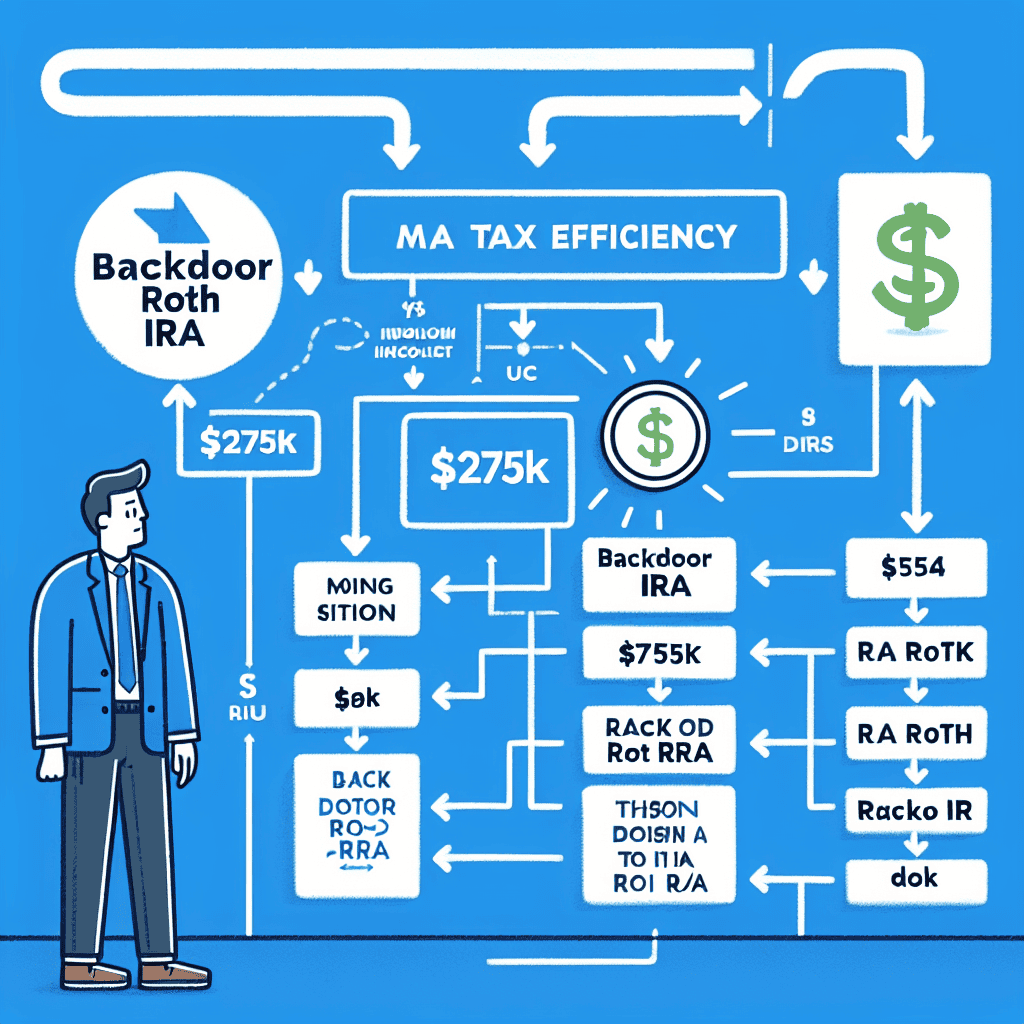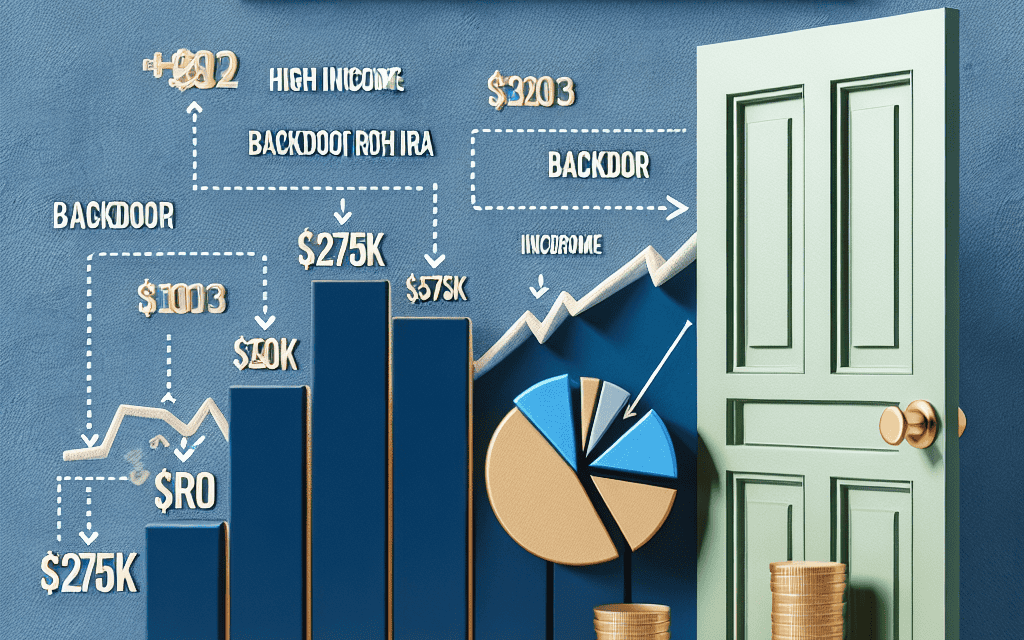“Unlock Tax Savings: Discover if a Backdoor Roth IRA Fits Your $275k Income Strategy!”
Introduction
Maximizing tax efficiency is a crucial consideration for individuals seeking to optimize their financial strategies, particularly for those with higher incomes. For individuals earning $275,000 annually, traditional avenues for tax-advantaged retirement savings, such as direct contributions to a Roth IRA, may be limited due to income restrictions. However, the Backdoor Roth IRA presents a viable alternative, allowing high-income earners to reap the benefits of tax-free growth and withdrawals in retirement. This strategy involves making nondeductible contributions to a traditional IRA and subsequently converting those funds to a Roth IRA, thereby circumventing the income limits associated with direct Roth IRA contributions. Understanding the intricacies of this approach, including potential tax implications and the pro-rata rule, is essential for determining whether a Backdoor Roth IRA aligns with one’s financial goals and tax planning needs.
Understanding the Backdoor Roth IRA: A Guide for High-Income Earners
For high-income earners, navigating the complexities of tax-efficient retirement planning can be a daunting task. One strategy that has gained popularity among individuals with substantial incomes is the backdoor Roth IRA. This approach offers a unique opportunity to enjoy the benefits of a Roth IRA, even when income levels exceed the standard eligibility limits. Understanding the nuances of this strategy is crucial for those with an income of $275,000 or more, as it can significantly impact long-term financial planning.
The backdoor Roth IRA is essentially a two-step process that allows high-income earners to bypass the income restrictions typically associated with Roth IRA contributions. Initially, individuals make a nondeductible contribution to a traditional IRA. Subsequently, they convert these funds into a Roth IRA. This conversion is the crux of the backdoor strategy, enabling individuals to take advantage of the tax-free growth and tax-free withdrawals that Roth IRAs offer. However, it is essential to consider the tax implications of this conversion, as the amount converted is subject to income tax.
For those with a $275,000 income, the backdoor Roth IRA presents an attractive option, primarily because it allows for tax diversification in retirement accounts. By having both traditional and Roth IRAs, individuals can strategically manage their tax liabilities in retirement, choosing which accounts to draw from based on their tax situation at the time. This flexibility can be particularly beneficial in mitigating the impact of required minimum distributions (RMDs) from traditional IRAs, which are taxed as ordinary income.
Moreover, the backdoor Roth IRA can serve as a hedge against future tax rate increases. Given the uncertainty surrounding future tax policies, having a portion of retirement savings in a Roth IRA can provide peace of mind, knowing that withdrawals will not be subject to higher tax rates. This foresight is especially pertinent for high-income earners who may face significant tax burdens in retirement.
However, it is crucial to be aware of potential pitfalls associated with the backdoor Roth IRA. One such consideration is the pro-rata rule, which can complicate the conversion process if an individual has other traditional IRA assets. The pro-rata rule requires that all traditional IRA assets be considered when calculating the taxable portion of a Roth conversion. This means that if an individual has pre-tax funds in any traditional IRA, a portion of the conversion will be taxable, potentially diminishing the tax efficiency of the strategy.
Additionally, it is important to stay informed about legislative changes that could impact the viability of the backdoor Roth IRA. While this strategy is currently permissible, tax laws are subject to change, and high-income earners should remain vigilant about any modifications that could affect their retirement planning strategies.
In conclusion, for individuals with a $275,000 income, the backdoor Roth IRA offers a compelling opportunity to enhance tax efficiency and diversify retirement savings. By understanding the intricacies of this strategy and considering the potential tax implications, high-income earners can make informed decisions that align with their long-term financial goals. As with any financial strategy, consulting with a tax advisor or financial planner is advisable to ensure that the backdoor Roth IRA aligns with one’s overall retirement planning objectives and to navigate any complexities that may arise.
Tax Benefits of a Backdoor Roth IRA for Individuals Earning $275k
For individuals earning a substantial income, such as $275,000 annually, maximizing tax efficiency becomes a crucial aspect of financial planning. One strategy that has gained popularity among high-income earners is the backdoor Roth IRA. This financial maneuver allows individuals to bypass the income limits traditionally associated with Roth IRA contributions, thereby enabling them to enjoy the tax benefits that come with such accounts. Understanding the tax advantages of a backdoor Roth IRA can help individuals make informed decisions about their retirement savings strategy.
To begin with, a Roth IRA offers significant tax benefits, primarily because contributions are made with after-tax dollars. This means that while there is no immediate tax deduction, the funds grow tax-free, and qualified withdrawals in retirement are also tax-free. For high-income earners, this can be particularly advantageous, as it provides a hedge against future tax rate increases. However, the IRS imposes income limits on direct contributions to a Roth IRA, which can be a barrier for those earning $275,000. This is where the backdoor Roth IRA comes into play.
The backdoor Roth IRA is a legal method that allows individuals to circumvent these income restrictions. It involves making a nondeductible contribution to a traditional IRA and then converting those funds to a Roth IRA. While this process may seem complex, it is a straightforward way to gain access to the benefits of a Roth IRA without being subject to the income limitations. Importantly, the conversion process itself is not subject to income limits, making it an attractive option for high earners.
One of the primary tax benefits of utilizing a backdoor Roth IRA is the potential for tax-free growth. Given that individuals with a $275,000 income are likely in a higher tax bracket, the ability to grow investments without the burden of taxes can significantly enhance the overall return on investment. Over time, this tax-free growth can lead to substantial savings, particularly when compared to taxable investment accounts where gains are subject to capital gains taxes.
Moreover, a backdoor Roth IRA can provide tax diversification in retirement. By having a mix of taxable, tax-deferred, and tax-free accounts, individuals can strategically manage their withdrawals to minimize their tax liability in retirement. This flexibility can be particularly beneficial for high-income earners who may face higher tax rates in the future. Additionally, unlike traditional IRAs, Roth IRAs do not have required minimum distributions (RMDs) during the account holder’s lifetime, allowing for greater control over the timing and amount of withdrawals.
However, it is essential to consider potential pitfalls when executing a backdoor Roth IRA. One such consideration is the pro-rata rule, which requires that all traditional IRA accounts be considered when calculating the taxable portion of a conversion. This means that if an individual has other traditional IRAs with pre-tax contributions, a portion of the conversion may be taxable. Therefore, careful planning and possibly consulting with a financial advisor are recommended to ensure the strategy is executed correctly and efficiently.
In conclusion, for individuals earning $275,000, a backdoor Roth IRA can be a valuable tool for maximizing tax efficiency. By allowing access to the benefits of a Roth IRA without income restrictions, it offers the potential for tax-free growth and greater flexibility in retirement planning. While there are complexities involved, the long-term advantages can make it a worthwhile consideration for those seeking to optimize their financial strategy.
Step-by-Step Process to Implement a Backdoor Roth IRA Strategy
Maximizing tax efficiency is a crucial consideration for individuals with a higher income, such as those earning $275,000 annually. One strategy that has gained popularity among high-income earners is the backdoor Roth IRA. This approach allows individuals to circumvent the income limits associated with direct Roth IRA contributions, thereby enabling them to enjoy the benefits of tax-free growth and withdrawals in retirement. Understanding the step-by-step process to implement a backdoor Roth IRA strategy is essential for those looking to optimize their retirement savings.
The first step in this process involves contributing to a traditional IRA. Since there are no income limits for making non-deductible contributions to a traditional IRA, individuals with a $275,000 income can contribute up to the annual limit, which is $6,500 for those under 50 and $7,500 for those 50 and older, as of 2023. It is important to note that these contributions are made with after-tax dollars, meaning they do not reduce your taxable income for the year.
Once the contribution to the traditional IRA is made, the next step is to convert these funds into a Roth IRA. This conversion is the crux of the backdoor Roth IRA strategy. It is crucial to execute this conversion promptly to minimize any potential gains in the traditional IRA, which would be subject to taxes upon conversion. The conversion process involves notifying your financial institution of your intent to convert the traditional IRA funds into a Roth IRA. This step is relatively straightforward, but it is advisable to consult with a financial advisor or tax professional to ensure compliance with IRS regulations.
A key consideration during the conversion process is the pro-rata rule, which can complicate the tax implications of a backdoor Roth IRA. The pro-rata rule requires that all traditional IRA accounts be considered when calculating the taxable portion of the conversion. Therefore, if you have other traditional IRAs with pre-tax contributions, a portion of the conversion will be taxable. To mitigate this, some individuals choose to roll over pre-tax IRA funds into an employer-sponsored retirement plan, such as a 401(k), before executing the backdoor Roth IRA strategy. This step can help isolate the non-deductible contributions, thereby minimizing the tax impact.
After successfully converting the traditional IRA funds into a Roth IRA, it is essential to maintain accurate records of the transactions. Keeping detailed documentation of the initial contribution, the conversion, and any associated tax forms will be invaluable when filing taxes. The IRS requires Form 8606 to be filed with your tax return to report non-deductible contributions and conversions, ensuring that you are not taxed twice on the same funds.
In conclusion, implementing a backdoor Roth IRA strategy can be an effective way for high-income earners to maximize their tax efficiency and secure tax-free growth for their retirement savings. By carefully following the step-by-step process of contributing to a traditional IRA, converting to a Roth IRA, and managing the tax implications, individuals can take advantage of this strategy. However, given the complexities involved, it is advisable to seek guidance from financial and tax professionals to ensure compliance and optimize the benefits of a backdoor Roth IRA.
Comparing Traditional IRA and Backdoor Roth IRA for Tax Efficiency

When considering strategies for maximizing tax efficiency, individuals with a higher income, such as $275,000 annually, often explore various retirement savings options. Among these, the Traditional IRA and the Backdoor Roth IRA are frequently discussed. Understanding the nuances of each can help in making an informed decision that aligns with one’s financial goals.
The Traditional IRA is a popular choice for many due to its immediate tax benefits. Contributions to a Traditional IRA may be tax-deductible, which can lower your taxable income for the year in which the contributions are made. This immediate tax relief can be particularly appealing for high-income earners looking to reduce their current tax liability. However, it is important to note that the tax benefits of a Traditional IRA are deferred. This means that while you may enjoy tax deductions now, you will be required to pay taxes on withdrawals during retirement, which could potentially be at a higher tax rate depending on future income and tax laws.
In contrast, the Backdoor Roth IRA offers a different set of advantages, particularly for those whose income exceeds the limits for direct Roth IRA contributions. The Backdoor Roth IRA is a strategy that involves making a non-deductible contribution to a Traditional IRA and then converting those funds to a Roth IRA. This approach allows high-income earners to bypass the income restrictions associated with Roth IRAs. One of the primary benefits of a Roth IRA is that qualified withdrawals during retirement are tax-free, provided certain conditions are met. This can be a significant advantage if you anticipate being in a higher tax bracket in the future or if you expect tax rates to rise.
When comparing these two options, it is crucial to consider your current and projected future tax situations. If you believe that your tax rate will be lower in retirement, a Traditional IRA might be more beneficial due to the immediate tax deductions. However, if you expect your tax rate to be higher or if you value the certainty of tax-free income in retirement, the Backdoor Roth IRA could be the more advantageous choice.
Moreover, the decision between a Traditional IRA and a Backdoor Roth IRA should also take into account other factors such as estate planning and the desire for flexibility in retirement. Roth IRAs do not have required minimum distributions (RMDs) during the account holder’s lifetime, which can provide more control over your retirement funds and potentially leave a larger inheritance to beneficiaries.
In conclusion, both the Traditional IRA and the Backdoor Roth IRA offer unique benefits that can enhance tax efficiency, but the right choice depends on individual circumstances and financial goals. High-income earners should carefully evaluate their current tax situation, future income expectations, and retirement objectives. Consulting with a financial advisor can provide personalized insights and help navigate the complexities of these retirement savings options. By strategically selecting the appropriate IRA, individuals can optimize their tax efficiency and work towards a more secure financial future.
Common Mistakes to Avoid When Setting Up a Backdoor Roth IRA
When considering the strategic financial move of setting up a Backdoor Roth IRA, especially with an income of $275,000, it is crucial to navigate the process with precision to maximize tax efficiency. A Backdoor Roth IRA can be an excellent tool for high-income earners who exceed the income limits for direct Roth IRA contributions. However, there are common mistakes that can undermine the benefits of this strategy, and understanding these pitfalls is essential for optimizing your retirement savings.
One of the most frequent errors involves neglecting the pro-rata rule, which can significantly impact the tax implications of your conversion. The pro-rata rule requires that all of your traditional IRAs be considered when calculating the taxable portion of your conversion. This means that if you have pre-tax funds in any traditional IRA, SEP IRA, or SIMPLE IRA, a portion of your conversion will be taxable. To avoid this, some individuals choose to roll over their pre-tax IRA funds into an employer-sponsored 401(k) plan, if allowed, thereby isolating the non-deductible contributions for conversion.
Another common mistake is failing to report the conversion correctly on your tax return. The process involves two key steps: making a non-deductible contribution to a traditional IRA and then converting those funds to a Roth IRA. It is imperative to file IRS Form 8606 to report the non-deductible contribution, as this form tracks your basis in the IRA and ensures you are not taxed twice on the same money. Omitting this form can lead to unnecessary tax liabilities and complications with the IRS.
Timing is also a critical factor in executing a Backdoor Roth IRA. Some individuals mistakenly believe they must wait a certain period between the contribution and conversion steps. While there is no official waiting period mandated by the IRS, executing the conversion promptly can help avoid any potential issues with the step transaction doctrine, which the IRS could use to argue that the two steps were essentially one transaction. By completing the conversion soon after the contribution, you minimize the risk of this interpretation.
Additionally, overlooking the impact of state taxes can be a costly oversight. While federal tax implications are often the primary focus, state taxes can also affect the overall efficiency of a Backdoor Roth IRA. Some states do not conform to federal tax rules regarding Roth conversions, which could result in unexpected state tax liabilities. Consulting with a tax professional who understands the nuances of your state’s tax laws can help mitigate this risk.
Finally, it is essential to consider the long-term implications of a Backdoor Roth IRA. While the immediate tax benefits are appealing, it is important to evaluate how this strategy fits into your overall retirement plan. Factors such as future tax rates, retirement income needs, and estate planning goals should all be considered. A comprehensive approach ensures that the Backdoor Roth IRA aligns with your financial objectives and maximizes the potential benefits.
In conclusion, while a Backdoor Roth IRA can be a powerful tool for high-income earners seeking tax-efficient retirement savings, careful attention to detail is necessary to avoid common mistakes. By understanding the pro-rata rule, accurately reporting conversions, considering timing, accounting for state taxes, and evaluating long-term goals, you can effectively leverage this strategy to enhance your financial future.
Long-Term Financial Planning: The Role of a Backdoor Roth IRA
In the realm of long-term financial planning, the quest for tax efficiency is a critical consideration for individuals with substantial incomes. For those earning $275,000 annually, the challenge often lies in navigating the complexities of tax regulations to optimize retirement savings. One strategy that has gained traction among high-income earners is the Backdoor Roth IRA. This financial maneuver offers a pathway to enjoy the benefits of a Roth IRA, even when direct contributions are restricted due to income limits. Understanding whether a Backdoor Roth IRA is suitable for your financial situation requires a careful examination of its mechanics and potential advantages.
To begin with, it is essential to comprehend the fundamental structure of a Roth IRA. Unlike traditional IRAs, Roth IRAs allow for tax-free withdrawals in retirement, provided certain conditions are met. However, direct contributions to a Roth IRA are limited by income thresholds, which can be a barrier for high earners. In 2023, for instance, the ability to contribute directly to a Roth IRA begins to phase out for individuals with a modified adjusted gross income (MAGI) exceeding $138,000, and is completely phased out at $153,000. For married couples filing jointly, the phase-out range is between $218,000 and $228,000. Consequently, individuals with a $275,000 income are precluded from making direct contributions.
This is where the Backdoor Roth IRA comes into play. Essentially, it involves making a nondeductible contribution to a traditional IRA, which is not subject to income limits, and subsequently converting those funds to a Roth IRA. This conversion is permissible regardless of income level, thus providing a legal loophole for high earners to benefit from the tax advantages of a Roth IRA. However, it is crucial to be aware of the potential tax implications during the conversion process. If the traditional IRA contains any pre-tax contributions, a portion of the conversion may be subject to income tax, calculated using the pro-rata rule.
Despite these considerations, the Backdoor Roth IRA can be an attractive option for those seeking to maximize their retirement savings. One of the primary benefits is the potential for tax-free growth, which can be particularly advantageous over a long investment horizon. Additionally, Roth IRAs do not have required minimum distributions (RMDs) during the account holder’s lifetime, allowing for greater flexibility in retirement planning. This feature can be especially beneficial for individuals who anticipate being in a higher tax bracket in retirement or who wish to leave a tax-free inheritance to their heirs.
Nevertheless, it is important to weigh these benefits against potential drawbacks. The pro-rata rule can complicate the tax situation, especially for those with existing traditional IRAs. Moreover, legislative changes could impact the viability of the Backdoor Roth IRA strategy in the future. Therefore, it is advisable to consult with a financial advisor or tax professional to assess the suitability of this approach in the context of your overall financial plan.
In conclusion, while the Backdoor Roth IRA presents a compelling opportunity for high-income earners to enhance their retirement savings, it is not a one-size-fits-all solution. By carefully considering the tax implications and aligning the strategy with long-term financial goals, individuals with a $275,000 income can make informed decisions about incorporating a Backdoor Roth IRA into their financial planning arsenal.
Evaluating the Risks and Rewards of a Backdoor Roth IRA Conversion
When considering strategies to maximize tax efficiency, individuals with a higher income, such as $275,000 annually, often explore the potential benefits of a Backdoor Roth IRA conversion. This financial maneuver allows high-income earners, who typically exceed the income limits for direct Roth IRA contributions, to enjoy the advantages of a Roth IRA by converting a traditional IRA into a Roth IRA. However, before proceeding with this strategy, it is crucial to evaluate both the risks and rewards associated with a Backdoor Roth IRA conversion.
One of the primary rewards of a Backdoor Roth IRA is the potential for tax-free growth and withdrawals. Unlike traditional IRAs, Roth IRAs allow for tax-free withdrawals in retirement, provided certain conditions are met. This can be particularly advantageous for individuals in higher tax brackets, as it enables them to lock in their current tax rate and potentially avoid higher taxes in the future. Additionally, Roth IRAs do not have required minimum distributions (RMDs) during the account holder’s lifetime, offering more flexibility in retirement planning and the potential for continued tax-free growth.
However, the conversion process is not without its risks. One significant consideration is the immediate tax liability incurred during the conversion. When converting a traditional IRA to a Roth IRA, the account holder must pay taxes on any pre-tax contributions and earnings. For someone with a $275,000 income, this could result in a substantial tax bill, particularly if the conversion pushes them into a higher tax bracket. Therefore, it is essential to carefully assess one’s current and projected future tax situation to determine if the long-term benefits outweigh the immediate costs.
Moreover, the pro-rata rule can complicate the conversion process. This rule requires that all traditional IRAs be considered when calculating the taxable portion of a conversion. Consequently, if an individual has other traditional IRAs with pre-tax contributions, a portion of the conversion will be taxable, potentially increasing the overall tax burden. To mitigate this risk, some individuals choose to roll over existing pre-tax IRAs into an employer-sponsored retirement plan, such as a 401(k), before executing a Backdoor Roth IRA conversion.
Another factor to consider is the potential for legislative changes. Tax laws are subject to change, and while Roth IRAs currently offer tax-free withdrawals, future legislation could alter these benefits. Although it is impossible to predict future tax policy with certainty, individuals should remain informed about potential changes and consider how they might impact their retirement strategy.
In addition to these considerations, it is important to evaluate one’s overall financial goals and retirement timeline. A Backdoor Roth IRA conversion may be more beneficial for those who anticipate being in a higher tax bracket during retirement or who have a longer time horizon to allow for tax-free growth. Conversely, individuals who expect to be in a lower tax bracket in retirement or who require access to their funds sooner may find that the immediate tax costs outweigh the potential benefits.
Ultimately, the decision to pursue a Backdoor Roth IRA conversion should be made in consultation with a financial advisor or tax professional. These experts can provide personalized guidance based on an individual’s unique financial situation and goals, helping to ensure that the chosen strategy aligns with their long-term objectives. By carefully weighing the risks and rewards, individuals with a $275,000 income can make informed decisions about whether a Backdoor Roth IRA is the right choice for maximizing their tax efficiency.
Q&A
1. **What is a Backdoor Roth IRA?**
A Backdoor Roth IRA is a strategy that allows high-income earners to contribute to a Roth IRA by first making a nondeductible contribution to a traditional IRA and then converting it to a Roth IRA.
2. **Why consider a Backdoor Roth IRA with a $275k income?**
Individuals with a $275k income exceed the IRS income limits for direct Roth IRA contributions, making the Backdoor Roth IRA a viable option to take advantage of tax-free growth and withdrawals.
3. **What are the tax implications of a Backdoor Roth IRA?**
The conversion from a traditional IRA to a Roth IRA may trigger taxes on any pre-tax contributions or earnings, but future growth and withdrawals from the Roth IRA are tax-free.
4. **Are there any contribution limits for a Backdoor Roth IRA?**
The contribution limit for a Backdoor Roth IRA is the same as for a traditional IRA, which is $6,500 for individuals under 50 and $7,500 for those 50 and older in 2023.
5. **What is the pro-rata rule in a Backdoor Roth IRA?**
The pro-rata rule requires that all traditional, SEP, and SIMPLE IRAs be considered when calculating the taxable portion of a Roth conversion, potentially complicating the tax situation.
6. **Can I perform a Backdoor Roth IRA conversion every year?**
Yes, as long as you adhere to IRS rules and contribution limits, you can perform a Backdoor Roth IRA conversion annually.
7. **What are the benefits of a Backdoor Roth IRA for high-income earners?**
Benefits include tax-free growth, no required minimum distributions (RMDs) during the account holder’s lifetime, and the ability to pass on tax-free assets to heirs.
Conclusion
A Backdoor Roth IRA can be a strategic option for maximizing tax efficiency for individuals with a $275k income, especially if they are ineligible to contribute directly to a Roth IRA due to income limits. By converting a traditional IRA to a Roth IRA, individuals can benefit from tax-free growth and withdrawals in retirement. However, it’s essential to consider potential tax implications during the conversion process, such as the pro-rata rule, which could affect the tax owed. Consulting with a financial advisor or tax professional is advisable to ensure that a Backdoor Roth IRA aligns with your overall financial strategy and retirement goals.





